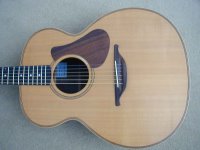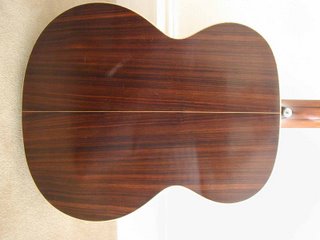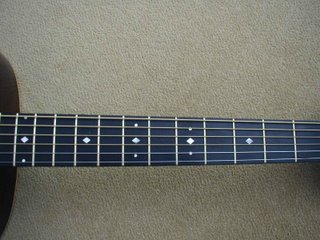Here is an article I wrote for the inaugural issue of Acoustic in magazine. Luckily I have a republishing rights clause in my contract with them so I present my earlier work in an unedited form, but with additional pictures for your pleasure.
George Lowden 1979 L32 ‘Least Likely’

This wonderful guitar designated L32 is in good condition with some play wear and a few minor side cracks. Constructed with Indian Rosewood and Spruce, this guitar pre-dates any factory Lowdens, and was made in a shop by George Lowden and 4 apprentices. It’s one of 70 guitars from the earliest period in the illustrious history of Lowden guitars.
The Indian rosewood was purchased from a wood merchant’s in London by George himself and painstakingly driven back to Ireland and resawn! The design aesthetic is classic Lowden; a handrubbed satin finish is present through with curly maple bindings and all wood purfling and rosette. It has a very comfortable egg shaped neck profile which almost feels moulded to your hand and a 1.75 inch nut width makes for fingerstyle and flatpicking a pleasure. Custom dots and diamond inlays adorn the fingerboard and it even retains the original bone nut, saddle and very early Calton case.
wood purfling and rosette. It has a very comfortable egg shaped neck profile which almost feels moulded to your hand and a 1.75 inch nut width makes for fingerstyle and flatpicking a pleasure. Custom dots and diamond inlays adorn the fingerboard and it even retains the original bone nut, saddle and very early Calton case.
The L32 is the same body shape as the modern O series. This is a big guitar approximately the size of a Gibson J200 but it is ergonomical because of it’s curvaceous outline. Thus it sits nicely in the lap and the playing hand is nicely supported by the upper bout. It is unsurprising that the body is exactly the same as it’s modern sister O models.
This is one of only 3 Lowdens I have played which has appealed to me and I have played many Lowdens from Van Morrison’s 1991 L25 to a mid 80’s 0 made solely by George Lowden. It is truly a majestic guitar; the curves and design aesthetic has weathered the years with grace and the sound simply takes one’s breath away. In fact this was the very first Lowden that I wanted after being disappointed with so many of the previous Lowdens I had played, hence the nickname ‘least likely’.
It's a great fingerpicker with a clear, responsive tone that is surrounded by the characteristic Lowden overtones. Dennis Czech summed it best: “It has the authority, the clarity, the roundedness and fullness of tone, the mature, solid, muscly strength of a good vintage Martin. Quite wonderful. For such a big guitar, it has very clear and responsive trebles and yes, there is that desirable evenness of tone all the way across the fretboard.”

The fun doesn’t stop there. Although is a great guitar in it's own right, this guitar also has a fantastic pedigree:
- It is made by George himself before any factory involvement.
- It was originally owned by Garth Hewitt, a Christian singer/writer
- In the late 80’s to early 90’s it was bought by Paul Stacey who is best known for producing Oasis, although it is unsure that the guitar was ever used by them. Paul was a well known session guitarist and band member of the Lemon Trees with Guy Chambers who went on to produce and co-write for Robbie Williams. Paul went on to engineer Oasis and now runs his own studio.
- Huw Price acquired it on 4th February 1993. Huw is a freelance producer, sound engineer and writer. It is the guitar seen on the cover of "Recording guitar and bass- Getting a great sound every time you record" Price, Huw; Back Beat Books 2002; ISBN 0-87930-730-7. It was also used on the following albums:
- Delicious Monster - their last EP 3 songs
- Stereolab - first album (space age batchelor pad music/super electric)
- Becky Duke - "like it like this"
- Venas Pluton - first album 1 track (Pinophilia/Petaco/Binocular )
- Frank Tovey - various recordings (Worried Man In Second - Hand Suits/The Best Of Fad Gadget)
- I purchased the guitar from Huw in October of 2003.
- It was my main guitar until a private collector who wishes to remain anonymous acquired it in September 2004 where it remains in his possession.

The current owner wrote to me recently declaring that it was the best Lowden he had ever played, and he has one from almost every era of George Lowden’s production. I strongly believe that the older Lowdens especially those which predate any factory production have something special; George maintained not only a very high build quality, but the materials were more closely selected than possible in a production facility.
Furthermore, small changes in the design over the years have impacted on the Lowden sound. For instance, although minor, the symmetry between the bridge, soundhole and the body had changed by the late 1980’s such that the neck is noticeable further away from the player on later Lowdens. However, the Dolphin shaped bracing, much beloved by Lowden aficionados has made a comeback with George’s new workshop. But that’s another article entirely….

Quick Specs:
- Designated the L32 now the O model
- Made 1979 by George Lowden
- Spruce top
- Indian Rosewood back and sides
- Satin finish throughout
- Brazilian rosewood bridge
- Lowden decal on headstock
- Schaller tuners
- Curly maple Bindings
- All wood purfling and rosette
- Custom fret markers
- Bone nut and saddle
C. Tan Liwen Terence 2004.
Terence is a medic currently based in London where he also runs goodacoustics.com the UK’s only shop exclusively carrying luthier made guitars with a business partner and a tonewoods supply house specialising in Salvaged Brazilian Rosewood and European spruce. He is an active musician gigging regularly and a freelance journalist. Please send correspondence to liwen.tan@imperial.ac.uk
 I'm pretty excited about the Randy Lucas Jumbo we've gotten in. It's a top notch instrument in every respect. I'm hard to please, but this is one guitar I just smile at.
I'm pretty excited about the Randy Lucas Jumbo we've gotten in. It's a top notch instrument in every respect. I'm hard to please, but this is one guitar I just smile at. back of the headstock and the entire body, neck and headstock is bound in ivoroid with wood purfling.
back of the headstock and the entire body, neck and headstock is bound in ivoroid with wood purfling.






